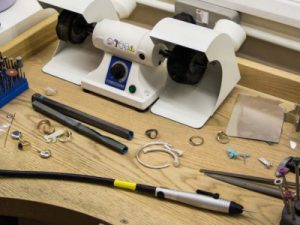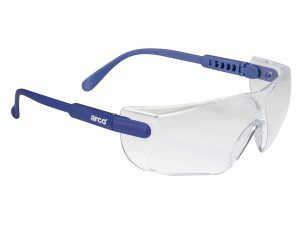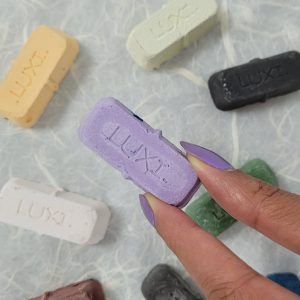Polishing is a crucial part of jewellery making and is a process which creates a high quality finish on the surface of metal items. The polishing process works to remove hair line scratches, marks and dullness leaving behind a professional finish, however it is important that the metal surface is properly prepared for polishing. Use wet and dry paper to remove deep scratches or surface imperfections, starting with 500 grit and working to 2000. There are no quick ways to produce a high quality finish on jewellery, but there a many tools and accessories that will help the process move along faster.

When a jewellery item is poorly polished it will make even the most well designed piece look lacklustre. This is where knowing how to use a polishing motor correctly is necessary. Although there is no one clear method, a good knowledge of the process will allow you to choose the correct tools and processes for polishing any given jewellery item.
When polishing take the time to read the instructions that are supplied with your polishing machine or pendent motor. All machines are supplied with instructions which will identify the correct ways to use said machine and highlight specific hazards associated with that machine. Take the time to also familiarize yourself with the data safety sheets which are supplied with different polishing compounds, which provides relevant details including hazardous identification, information on ingredients of compounds, first aid measures and personal protection measures.

You must wear appropriate personal protective equipment, or PPE, when polishing. When considering PPE it is a good idea to look at what you are wearing before you begin using your polishing motor. Are you appropriately dressed for the workshop? Long hair should be tied back, avoid long sleeves and necklaces, bracelets and other lose items should be removed before the machine is turned on. Additionally, wear a dust mask when polishing, and safety glasses.
There is a huge range of polishing mops available, all mops are made with a hole in the middle so that they can easily be fitted onto the tapered spindles that are on each end of the machine. When choosing a polishing mop, usually, we would choose a rougher calico mop for rough polishing and pre-polish and a soft mop for final polishing stages.
Polishing compound should be used in specific orders, starting with the most abrasive compound and finishing with the finest compound – traditionally a pre-polish such as Tripoli would be used with a calico mop followed by a final polish such as rouge used with a soft mop.

We now have multiple polishing compounds to choose from, including compounds more abrasive then Tripoli which can be used to remove scratches and compounds finer then rouge which can be used to achieve a mirror finish. The ‘Luxi Mini Polishing Set’ is a great investment to try a number of different polishes without committing to a large purchase, for each new polish use a new mop and take care to store different compounds with their mops and separate from one another so as to avoid cross contamination of compounds. For best results use an ultrasonic to clean off the pre-polish before doing the final polish.
When polishing, it is recommended you work within the bottom third of the mop, this area of the mop has the least drag where the risk of getting your piece caught in the machine is minimal. Apply a layer of polish to the mop, take care it is not caked on. Once the compound has been applied, introduce your jewellery item to the mop with light to medium pressure – this will remove any initial dullness, and can remove light scratches depending on the compound used. You may now need to apply some additional compound before continuing. Regularly move your piece along the wheel to ensure all sides and areas are getting polished, keeping your piece in place for too long risks damage.
Polishing motors are suitable for polishing a number of jewellery items, and larger metal items. Avoid polishing chains and very delicate items on a polishing motor, for chains consider barrel polishing as an alternative.
Once you understand the basics of beginning to use your polishing motor, the best advice any jeweller will give you is to continue practicing. The more you use your polishing motor, the better your skills will get.
Discover the polishing range here at Cooksongold and stock up on all the essentials you need to get your jewellery shining.


:max_bytes(150000):strip_icc():focal(999x0:1001x2)/rita-moreno-2024-oscars-031024-54cb2c55c28543c6893ec395fd29d6de.jpg)


